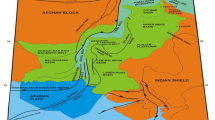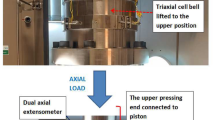Abstract
On the basis of Chapman’s (2003) model, as the seismic wave incidences angles vary from 0° to 45° while propagating in anisotropic media (HTI), the slow S-wave will sufferred by serious attenuation and dispersion and is sensitive to fluid viscosity but the P- and fast S-waves don’t. For slow S waves propagating normal to fractures, the amplitudes are strongly affected by pore fluid. So, the slow S-wave can be used to detect fractured reservoir fluid information when the P-wave response is insensitive to the fluid. In this paper, 3D3C seismic data from the Ken 71 area of Shengli Oilfield are processed and analyzed. The travel time and amplitude anomalies of slow S-waves are detected and correlated with well log data. The S-wave splitting in a water-bearing zone is higher than in an oil-bearing zone. Thus, the slow S-wave amplitude change is more significant in water-bearing zones than in oil-bearing zones.
Similar content being viewed by others
References
Angerer, E., Crampin, S., Li, X.Y., and Davis, T. L., 2002, Processing, modeling and predicting time-lapse effects of overpressured fluid-injection in a fractured reservoir: Geophysical Journal International, 149, 267–280.
Batzle, M., Han, D. H., and Hofmann, R., 2006, Fluid mobility and frequency-dependent seismic velocity — direct measurements: Geophysics, 71, N1–N9.
Chapman, M., Maultzsch, S., Liu, E., and Li, X. Y., 2003, The effect of fluid saturation in an anisotropic multi-scale equant porosity model: Journal of Applied Geophysics, 54, 191–202.
Chapman, M., 2003, Frequency-dependent anisotropy due to meso-scale fractures in the presence of equant porosity: Geophysical Prospecting, 51, 369–379.
Gassmann, F., 1951, Uber die Elastizitat poroser Medien: Vierteljahrsschrift der Naturforschenden Gesellschaft, 96, 1–23.
Li, X. Y., 1998, Processing PP and PS waves in multicomponent sea-floor data for azimuthal anisotropy: theory and review: Processing 8th International Workshop on Seismic Anisotropy, 53, 607–610.
Liu, E., Queen, J. H., Li, X. Y., Chapman, M., Maultzsch, S., Lynn, H. B., and Chesnokov, E. M., 2003, Observation and analysis of frequency-dependent anisotropy from a multicomponent VSP at Bluebell-Altamont Field, Utah: Journal of Applied Geophysics, 54, 319–333.
Maultzsch, S., Chapman, M., Liu, E., and Li, X. Y., 2003, Modeling frequency-dependent seismic anisotropy in fluid-saturated rock with aligned fractures: implications of fracture size estimation from anisotropic measurements: Geophysical Prospecting, 51, 381–392.
Schoenberg, M., and Douma, J., 1988, Elastic-wave propagation in media with parallel fractures and aligned cracks: Geophysical Prospecting, 36, 571–590.
Thomsen, L., 1995, Elastic anisotropy due to aligned cracks in porous rock: Geophysical Prospecting, 43, 805–829.
Thomsen, L., 2002, Understanding seismic anisotropy in exploration and exploitation: SEG Distinguished Instructor Series, No. 5.
Yuan, J., 2001, Analysis of four-component sea-floor seismic data for seismic anisotropy: PhD Thesis, University of Edinburgh.
Zatsepin, S. V., and Crampin, S., 1997, Modeling the compliance of crustal rock—I. Response of S-wave splitting to differential stress: Geophysical Journal International, 129, 477–494.
Author information
Authors and Affiliations
Additional information
This work was supported by the National 863 Program (Grant No. 2007AA060505).
Bi Li-Fei is a PhD student at China University of Geosciences (Wuhan) as well as a senior engineer in Shengli Geophysical Institute. His research mainly focuses on 3D3C seismic data processing and methods.
Rights and permissions
About this article
Cite this article
Bi, LF., Qian, ZP., Zhang, F. et al. Application of seismic anisotropy fluid detection technology in the Ken 71 well block of Shengli Oilfield. Appl. Geophys. 8, 117–124 (2011). https://doi.org/10.1007/s11770-011-0281-5
Received:
Revised:
Published:
Issue Date:
DOI: https://doi.org/10.1007/s11770-011-0281-5




